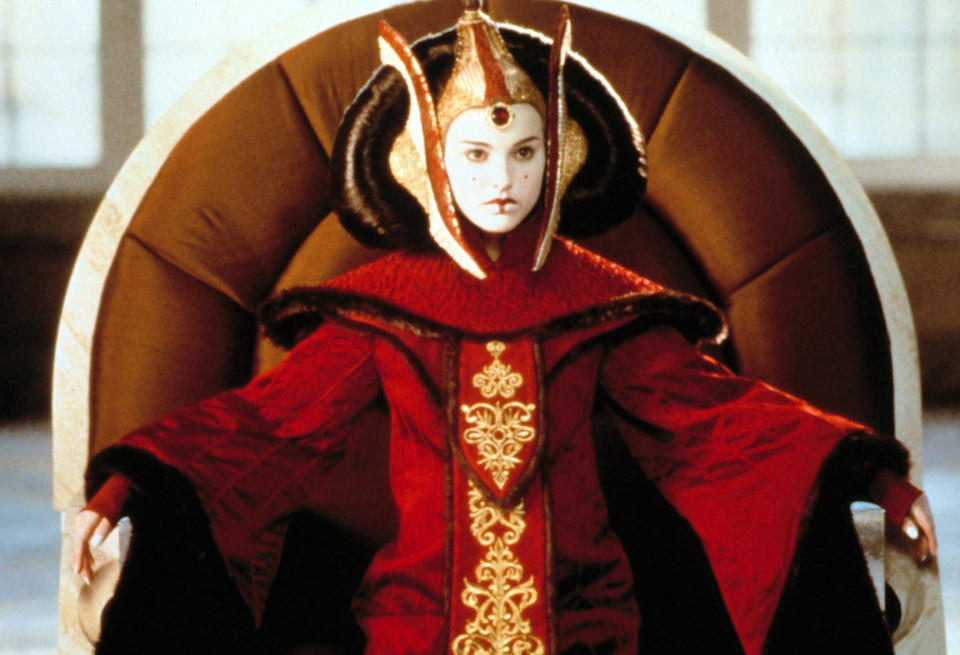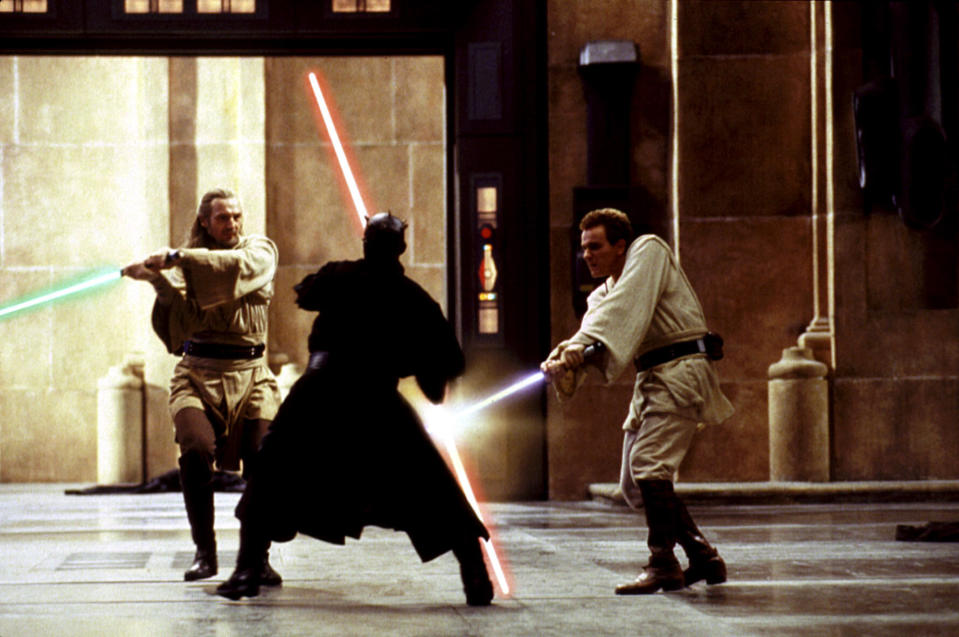'The Phantom Menace' at 20: How the first episode of the 'Star Wars' saga created toxic fandom
On May 19, 1999, Star Wars: Episode I — The Phantom Menace showed moviegoers that every saga has a beginning. The first entry in George Lucas’s prequel trilogy turned back the clock to a time before Death Stars and Starkiller Bases; a time when a young child from Tatooine took his first steps towards a dark future that would have major ramifications for the far, far away galaxy he called home. But The Phantom Menace also marked the beginning of a new disturbance in the Force, introducing an enemy who couldn’t be defeated by a lightsaber or a conveniently-located elevator shaft. We’re speaking, of course, about the villain known as “toxic nostalgia.” (Watch our video tribute above.)
Rather than define “toxic nostalgia” ourselves, let’s let a professional fan do the honors. Speaking with Yahoo Entertainment recently, actor-writer-producer and geek icon, Simon Pegg, offered a thoughtful explanation for how nostalgia can be a destructive force. It’s a subject that he explored onscreen in the 2013 film The World’s End, the third and final entry in the beloved Cornetto Trilogy that he oversaw with regular collaborators Edgar Wright and Nick Frost.
“Nostalgia even sounds kind of like a medical condition,” he says. “It’s a tendency to drift into the past as if the past was something that it wasn’t, and dwell there because it feels safer. There’s this notion called life-stage dissolution: the idea that the stages of our lives that we’re supposed to be at are changed at the forces in our society. We’re all like a lot of grown-up children right now. We’ve had a long period of peace and prosperity, and as a result everything we’re consuming is kind of in the realm of things we enjoyed as kids. That is an interesting situation to be in — it makes for a generation of people who don’t feel responsibility like adults used to.”
Thanks to the fact that both grown-up children and actual children have become mass consumers of older sci-fi, comic book and horror properties, we live in an era when fandom is ascendent. At the same time, arguments within fandom are fiercer than ever, particularly in the case of multi-generational franchises like Star Wars. Twenty years ago, The Phantom Menace was the first film to expose the generation gap between the fans who had grown up with Star Wars — and who loved it even when it fell out of fashion — versus those coming to it for the first time. Those raised on Lucas’s Original Trilogy had a very specific vision of Star Wars … and it’s definitely not the vision on display in The Phantom Menace.

A New Hope and its two sequels took place in a war-torn Wild West populated by scrappy Rebel soldiers, well-armed storm troopers and Joseph Campbell-inspired heroes. Menace, meanwhile, is set in a rigid galactic republic that’s stiff and formal to a fault. Viewed through that lens, the cast’s reserved performances — which are often criticized for being wooden — are entirely appropriate to the period the characters are living in. The same holds true for the ornate production design and set decoration, which fits that peaceful, prosperous time in the galaxy’s history.
Lucas’s intention was to depict a past that audiences had never seen onscreen before, and it had to look entirely different from the present they were intimately familiar with. Speaking at The Phantom Menace’s 20th anniversary panel at the 2019 Star Wars Celebration, prequel design director Doug Chiang recalled what Lucas told him early on in production: “On the very first day, George said, ‘Forget everything about what I said Star Wars is. He never considered it sci-fi—he considered it a period film. The idea we came up with that was Episode I was going to be in the ’20s and ’30s, whereas the original trilogy were the ’70s.”
The message of The Phantom Menace is that even the most stable of societies can topple with the smallest push — in this case a minor trade dispute that sets the stage for the rise of a previously obscure senator with imperial ambitions. As he did with A New Hope, Lucas cloaked that larger lesson in a PG-rated adventure that’s made with children in mind … but not the children who saw Star Wars in theaters in the ’70s. And so — unhappy with a Star Wars movie that wasn’t the Star Wars they remembered — a sizable segment of the fanbase made their displeasure known, embracing an image of themselves as the keepers of the flame, which meant that their opinion of Star Wars was the only correct opinion of Star Wars.
They found an outlet on the still-young medium the internet, where like-minded critics could congregate and launch their arguments or personal attacks anonymously out on the franchise’s creator and other fans as the prequel series continued. With time, these voices proved loud enough to reach outside of fan circles, finding their way into news coverage and even theatrically released films like 2010’s The People vs. George Lucas. The fact that their rage was powerful enough to fuel an entire feature-length documentary speaks to how, in the short term at least, the Star Wars franchise itself became toxic.

While Phantom Menace critics found lots to complain about, Jar Jar Binks — and the actor who played him, Ahmed Best — became a primary focus of their ire. That surprised Lucas, who has often called Jar Jar his favorite character in the film. It also shocked the film’s cast, parti Liam Neeson, who played Jedi master Qui-Gon Jinn. “There was some negative reaction to Jar Jar Binks, played by the wonderful, beautiful Ahmed Best,” the Irish actor told Yahoo Entertainment in January. “There were times we could just not stop laughing at what Ahmed was doing. I thought this was the next Eddie Murphy. When the film came out, this reaction to Jar Jar really did take me by surprise. I thought he was a wonderful, brilliant actor and I still do.”
The criticism from fans upset Best so much, he later revealed that he contemplated suicide. In an emotional Instagram post last summer, the Bronx-born actor wrote, “I don’t talk a lot about my experience as Jar Jar Binks, because a lot of it is very painful. I faced a media backlash that still affects my career today.” Fortunately, Best received a happier reception when he attended the 2019 Star Wars Celebration Phantom Menace panel. Taking the stage, he looked visibly moved by all the cheers and applause. “You guys are going to make me tear up,” he told the crowd.
A post shared by Ahmed Best (@bestahmed) on
While Best’s story has a happy ending, the rupture that occurred upon The Phantom Menace’s release has never fully healed two decades later. The anger left over from the prequel trilogy has seeped into reactions from the post-Lucas sequel trilogy, most notably Rian Johnson’s The Last Jedi. That film has become a target for a number of perceived sins against the spirit of Star Wars, from its depiction of an older, jaded Luke Skywalker to the ascendence of diverse characters like Rey, Finn and Rose. In fact, both Daisy Ridley and Kelly Marie Tran were subjected to such harsh online criticism, that they quit social media entirely. (Like Best, Tran found nothing but love at Star Wars Celebration.)
Many of these attacks can be traced back to the toxic nostalgia that Pegg talks about: the insistence that the things we enjoyed as kids always remain the same. And that demand isn’t just placed on Star Wars. Legacy film and television series like Ghostbusters, Star Trek, She-Ra, and the Marvel Universe all have their toxic fans, who are frequently the most resistant to attempts at allowing the franchise to evolve with the times and with the audience.

At the same time, it’s important to note that they haven’t been successful at stopping that evolution. Many of these franchises are arguably more popular now than they’ve ever been precisely because they’ve been expanding their worlds to make room for new fans that reject toxicity for inclusivity. For the record, toxic fans didn’t succeed in erasing The Phantom Menace from the history books either. Episode I remains among the five highest-grossing Star Wars movies. And now that the generation who saw it as kids have grown up, the movie’s reputation has even improved. Certainly, the final lightsaber duel pitting Jedi knights Qui-Gon and Obi-Wan against Darth Maul ranks among the finest Star Wars set-pieces. And Lucas’s depiction of a society blind to its internal divisions and thus susceptible to manipulation feels particularly prescient today.
That shift has been noted by none other than Mace Windu himself, Samuel L. Jackson, who shared with us these words of Jedi wisdom. “You can’t please everybody. It’s just the nature of what movies are and what entertainment is. I talk to people like you and other people who come in and go, ‘Oh my god, this is amazing!’ It’s a matter of opinion.”
Star Wars: Episode I — The Phantom Menace is available to purchase on Amazon, iTunes and Vudu.
Read more from Yahoo Entertainment:
May the Fourth: How 'Star Wars' has changed fans' lives forever
'The Star Wars Holiday Special' at 40: How a landmark TV bomb was born
Want daily pop culture news delivered to your inbox? Sign up here for Yahoo Entertainment & Lifestyle’s newsletter.


